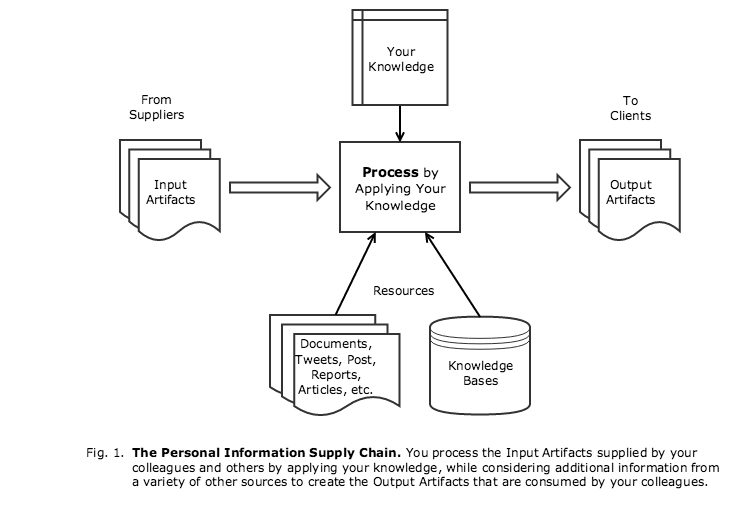Knowledge workers take in information, process it by applying their knowledge to it, and output information (possibly) in a different format than they received it. This looks like the information processing business.

This basic formula describes the essential building block of information processing. Applying this model to the individual knowledge worker provides some advantages. Allows us to critically examine each part of the model with the goal of understanding and improving the overall effectiveness of the knowledge worker: mostly when applied to ourselves.
That knowledge workers need to be in command of the information they use and produce has been known for well over 50 years, but very few ask the questions that will put them in charge. According to Peter Drucker:
To produce the information executives1 need for their work, they have to begin with two questions:
- What information do I owe to the people with whom I work and on whom I depend? In what form? And in what time frame?
- What information do I need myself? From whom? In what form? And in what time frame?
These two questions are closely connected. But they are different. What I owe comes first because it establishes communications. And unless that has been established, there will be no information flow back to the executive.2
Peter Drucker
There are three dimensions to the information needs as described by Drucker:
- Dependencies (who needs your output and who provides you input)
- Information artifacts (that you provide and receive) and their format
- Timeline for artifact delivery (time frame)
In this part 1 of a three-part series, let’s look at dependencies first and tackle the other two dimensions in subsequent articles.
Understanding your effectiveness starts with the critical examination of your own work. Who is depending on your work to complete their work? These are the people who are (sometimes) repeatedly asking for the slides, spreadsheets, design, unit test, component, or—fill in the blanks—from you. Some of these people will be complainers that you can’t please, but let's not talk about them now. Here let’s focus on those folks who legitimately need your output.
An insightful way to wrap your mind around this problem is to think of yourself as a “company of one person” or as consultant and author Tom Peters put it: “Me, Inc.” Think of the people expecting your output as your clients. Talk to your clients about their needs and identify what you have to do to fulfill those needs.
The same way, think of the input that you depend on. Identify the people who produce what you need. They are your suppliers. You need to provide them with the proper requirements to get what you need. Most likely you will have to iterate with them on the requirements, since you may not know exactly what you need at the outset of any project. Do not over constrain what they should deliver to you (you don’t like it when your clients do the same to you).
Looking at a concrete example: as a knowledge worker in a software company who do you depend on and who depends on you? For example, if you are a software engineer you work with other software engineers, product managers, business analysts, UI/UX designers, testers, sales people, customers, etc. Some of these people expect things from you, and with others you expect things from them. Identify the people that depend on you and the people that you depend on to get your work done.
Sometimes, especially on very small teams, you might be your own dependency, as in whatever you create now, two weeks or two months later you will be consuming it, too.
At the core, the essence of knowledge work is information processing. You are applying your knowledge to the inputs you receive to produce an output. Crisply identifying the inputs, outputs, and the knowledge required will help you understand what you do, and how can you do it better. In subsequent articles I’ll tackle the other two dimensions.
... continue to Part 2: Information Artifacts.
Footnotes
-
These days (in the early 21st century) when you read Peter Drucker writing about executives you can replace it with knowledge workers. 60+ years ago the majority of knowledge workers were executives, however today everybody who deals in information fits the definition. ↩
-
Drucker, Peter F. (2009-10-13). Management Challenges for the 21st Century (p. 124). HarperCollins. Kindle Edition. ↩